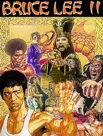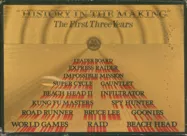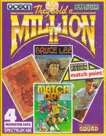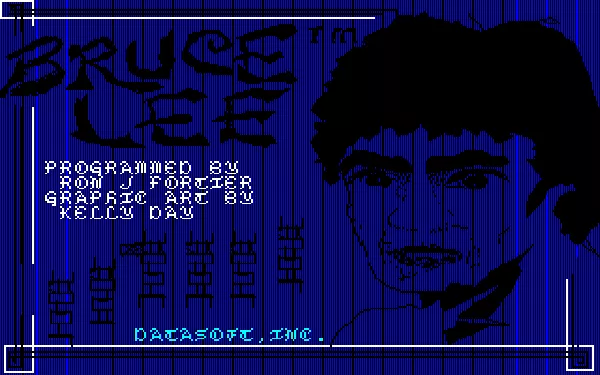Bruce Lee
Description official descriptions
The late martial arts hero features in this platform game, with the aim of reaching a wizard in an underground lair, defeat of whom can offer him untold wealth.
In each area you must collect the many strategically-placed lanterns before exiting through the newly-revealed passageway. Some rooms also have escalator-type sections to run along, and the standard (although slightly illogical in this context) ladders. There are 20 areas to be completed.
On the way, you'll fight two enemies - a ninja and a green sumo warrior named Yamo. You can defeat them by punching, kicking, dropping on their heads or luring them into hazardous terrain, or even by making them accidentally hit each other. Even after they are killed, however, they keep coming back for more after a few seconds. The game also allows a second player to take control of Yamo.
There are lots of hazards to avoid by either walking round or jumping - walls of electrical charge and exploding bushes for example.
Spellings
- ブルース・リー - Japanese spelling
Groups +
Screenshots
Promos
Credits (Commodore 64 version)
4 People
| Programming by | |
| Graphics by | |
| Music by | |
| Concept by | |
| Documentation by |
Reviews
Critics
Average score: 84% (based on 21 ratings)
Players
Average score: 3.8 out of 5 (based on 127 ratings with 5 reviews)
One of the great platformers of the era
The Good
Although it's actually a very short game, beatable in well under 30 minutes of play, this works to its advantage; the frustration of losing your last life at the infamous "fireball room" (which comes up right before the final boss) is made up for by the fact that it features lots of varied environments and gets more difficult as you progress through the game at a fairly consistent pace.
Instead of having fixed enemies like in almost all platformers, the enemies(two of them) spawn at random in Bruce Lee. This is a source of much of the excitement, as many unpredictable things can happen when the AI starts chasing after you; your fighting abilities are equal, in that you can both perform punches and flying kicks, take a few hits before dying, and crush each other by falling. (The player can also go prone and become immobile but able to avoid hits, but that's his only advantage) What makes it interesting is that a lot of rooms have laser beams(or plasma or electricity or spikes or something) that require timing to get by, and they will zap you if your fall or run is disturbed by the odd punch or kick.
The Bad
The controls can be a bit unforgiving; being designed for a 1-button joystick, you had to press up or diagonals to jump. To do a flying kick instead of a punch you had to start running and then press the button. In fact, the fights are probably the poorest part of the game, although they had the satisfying aspect of being able to trick the simplistic AI into its doom in many situations.
The final boss is not even a fight - it's like a precursor to Bowser in SMB1; not bad for 1984, but dated today. You run across the room, not getting hit by the relatively slow-moving bolts he fires, pick up a torch and it's all over. It's the rooms before him, disappointingly, that are the hard part.
The Bottom Line
A short, reasonably challenging(but not insanely so if you are an experienced gamer) and satisfying adventure. Running around collecting lanterns and torches and escaping a ninja and a green fat monster doesn't have too much to do with Bruce Lee's movies, but it makes for a fun game.
Commodore 64 · by James Hofmann (12) · 2004
A Martial Arts Multi-screen Platformer.
The Good
As with many of the games of it's time there was a thrill just clearing one screen to move to the next. If you were in the mood just to do some karate you could wait for the bad guys to re-spawn and keep beating them up. The platform action was top notch. And there was just the right amount of puzzle to figure out. The controls are simple and tight and perfect for the old one button joysticks.
The Bad
After finally figuring out how to get to the boss and then figuring out how to beat him, the game just rolls back around to the first screen all over again. It doesn't get much harder just more enemies come at you. There was not much incentive to work your way back up to the boss again.
The Bottom Line
Take a karate game where you get to punch and kick your way past your enemies and set it on a platform. Time your progress to avoid things when you need precise jumps. Throw in some logic puzzles where things need done in a certain order. And there you have Bruce Lee.
Want some two player fun? The second joystick controls the bad guy which makes for a very challenging game. Make sure you get all the lanterns and try touching anything that looks out of place. Practice your flying kicks grasshopper, they will serve you well.
Atari 8-bit · by gametrader (208) · 2006
Not so good on PC as it was on 8-bits
The Good
It's still solid fighting arcade game for the time, especially on PC (where good action games were scarce). Interconnected screens, pick up lanterns, there's action and challenge and you're happy when on your new run you reached one more screen further compared to your previous run.
The Bad
I didn't like gfx. It was not state-of-the-art even on other platforms, but PC was really ugly. Taking into account that Tandy was already available, using just smeary CGA-composite mode put the game to lower gfx quality compared to 8-bit platforms. Other options (CGA RGB, or monochrome) were even more ugly.
Edit: I found in the end, that it's possible to setup 16-color gfx by setting machine as PCjr in DOSBox/DOSBox-x, so plus point for Bruce Lee.
Sound was also PC beeper only.
Controller was really hard to setup. Bruce lot of times made different action than I desired, and I was not able to calibrate it (but maybe my argument is not valid as maybe it's controller dependent). Or in opposite, different attempts to calibrate joystick made sometime controller being insensitive in some directions. In the end, controls were always a bit clunky even after lot of attempts.
The Bottom Line
Not a bad game, but can't give it higher review score as I knew this game from 8-bit computers where it was way better in every aspect (gfx, sound, controls). PC port is IMO weak (to see what does mean good PC port of those times, check e.g. Pitfall II which I reviewed as well).
PC Booter · by Vladimir Dienes · 2023
Trivia
Awards
- Commodore Format
- January 1991 (Issue 4) - Listed in the 'A to Z of Classic Games' article (Great)
- Retro Gamer
- issue 37 – #18 in the "Top 25 Platformers of All Time" poll
- Zzap!
- May 1985 (Issue 1) - #15 'It's the Zzap! 64 Top 64!'
Analytics
Upgrade to MobyPro to view research rankings and price history! (when applicable)
Related Sites +
-
AtariMania (MCC, France, Atari 8-bit)
For Atari 8-bit: game entry database; downloadable release; game packaging; advertisement; manuals; magazine reviews; additional material. -
AtariMania (Rushware, Germany, Atari 8-bit)
For Atari 8-bit: game entry database; downloadable release; game packaging; advertisement; manuals; magazine reviews; additional material. -
AtariMania (US Gold, UK, Atari 8-bit)
For Atari 8-bit: game entry database; downloadable release; game packaging; advertisement; manuals; magazine reviews; additional material. -
Atarimania, an Atari database
for Atari world: dowloadable releases; artwork; additional material -
CPC-Power, an Amstrad CPC game database (in French)
for Amstrad CPC: dowloadable releases; artwork; additional material -
CPCRrulez (in French)
For Amstrad CPC: game database entry; advertisement; game packaging; downloadable releases; additional material. -
Cambridge Centre for Computing History (Americana, Amstrad CPC)
For Amstrad CPC464, cassette: exhibit reference ID CH19886; additional material. -
Cambridge Centre for Computing History (Code Masters/Ocean, ZX Spectrum)
For ZX Spectrum, Cassette: exhibit reference ID CH3762; additional material. -
Cambridge Centre for Computing History (DataSoft, C64)
For C64, Cassette: exhibit reference ID CH11741; additional material. -
Cambridge Centre for Computing History (Datasoft, BBC Micro)
For BBC Micro, Cassette: exhibit reference ID CH20691; additional material. -
Cambridge Centre for Computing History (US Gold, BBC Micro)
For BBC Micro, 5.25 floppy disc: exhibit reference ID CH36159; additional material. -
Cambridge Centre for Computing History (US Gold, C64)
For Commodore 64, 5.25" Floppy disk: exhibit reference ID CH31426; additional material. -
DOSBox, an x86 emulator with DOS
Compatibility information page about the original game and its DOSBox versions. -
Game Map
Direct access and downloadable archive -
Kio's home
For ZX Spectrum: additional material including – photographed cassette inlay; snapshots; downloadable releases. -
Lemon, a C64 game database
for C64: games, reviews and music -
MSX Generation
For MSX: game database entry; game packaging; manuals; additional material. -
Mark Rosten's Bruce Lee Remake
written in Blitz Basic for Windows. -
Program Bytes 48K (in Spanish)
Article in Spanish related to the combined versions of the game. By Neil Parsons. October, 18, 2008. -
The End Zone
Dedicated to end of game sequences with the objective of providing the most definitive and complete 'end of game' information ever assembled for the games featured. Includes video streaming of Bruce Lee from start to finish. -
The Tipshop
For ZX Spectrum: a central archive for all Spectrum and SAM games hints, tips, cheats, maps, hacks and pokes. -
Wikipedia
free Encyclopedia entry -
World of Spectrum
for ZX Spectrum: downloadable releases; additional material; remakes links; player reviews; magazine references; magazine adverts -
ZX Spectrum Reviews
For ZX Spectrum: magazine game reviews in HTML.
Identifiers +
Contribute
Are you familiar with this game? Help document and preserve this entry in video game history! If your contribution is approved, you will earn points and be credited as a contributor.
Contributors to this Entry
Game added by Donny K..
Sharp X1 added by Trypticon. Commodore 64 added by Quapil. iPad, iPhone added by Sciere. Amstrad CPC, ZX Spectrum added by Martin Smith. Antstream added by lights out party. FM-7, Apple II, Atari 8-bit added by Terok Nor. DOS added by gamer p. MSX added by koffiepad. PC-88 added by j.raido 【雷堂嬢太朗】. BBC Micro added by sabreman.
Additional contributors: PCGamer77, Martin Smith, lights out party, Macs Black, c64fan, Patrick Bregger, Karsa Orlong, FatherJack, ZeTomes, robMSX.
Game added August 9, 1999. Last modified March 2, 2025.


























